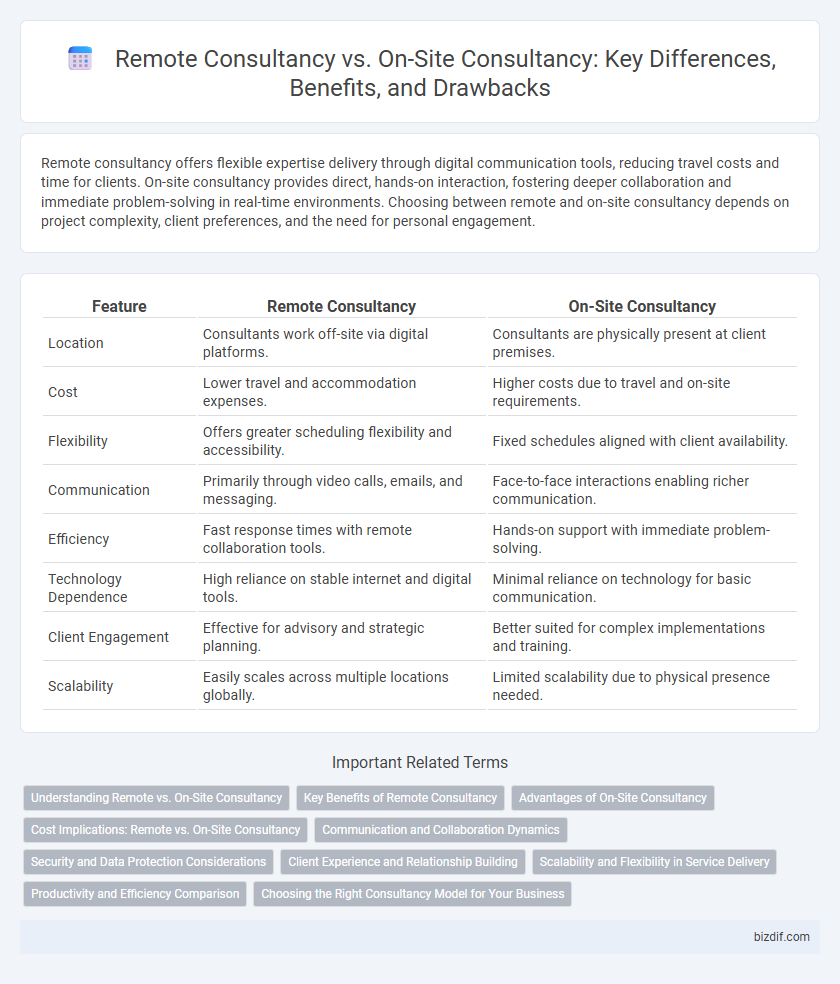Remote consultancy offers flexible expertise delivery through digital communication tools, reducing travel costs and time for clients. On-site consultancy provides direct, hands-on interaction, fostering deeper collaboration and immediate problem-solving in real-time environments. Choosing between remote and on-site consultancy depends on project complexity, client preferences, and the need for personal engagement.
Table of Comparison
| Feature | Remote Consultancy | On-Site Consultancy |
|---|---|---|
| Location | Consultants work off-site via digital platforms. | Consultants are physically present at client premises. |
| Cost | Lower travel and accommodation expenses. | Higher costs due to travel and on-site requirements. |
| Flexibility | Offers greater scheduling flexibility and accessibility. | Fixed schedules aligned with client availability. |
| Communication | Primarily through video calls, emails, and messaging. | Face-to-face interactions enabling richer communication. |
| Efficiency | Fast response times with remote collaboration tools. | Hands-on support with immediate problem-solving. |
| Technology Dependence | High reliance on stable internet and digital tools. | Minimal reliance on technology for basic communication. |
| Client Engagement | Effective for advisory and strategic planning. | Better suited for complex implementations and training. |
| Scalability | Easily scales across multiple locations globally. | Limited scalability due to physical presence needed. |
Understanding Remote vs. On-Site Consultancy
Remote consultancy leverages digital tools and virtual communication to deliver expert advice without geographic constraints, enhancing flexibility and reducing travel costs. On-site consultancy offers hands-on engagement, allowing consultants to directly assess environments, build stronger client relationships, and implement solutions in real-time. Choosing between remote and on-site consultancy depends on project complexity, client needs, and the value of face-to-face interaction for effective problem-solving.
Key Benefits of Remote Consultancy
Remote consultancy offers significant cost savings by eliminating travel expenses and reducing the need for physical office space. It provides flexible scheduling, enabling consultants to address client needs across different time zones efficiently. Enhanced access to a global talent pool allows businesses to benefit from specialized expertise without geographic limitations.
Advantages of On-Site Consultancy
On-site consultancy offers direct, real-time interaction that facilitates immediate problem-solving and tailored support, enhancing client understanding and engagement. Access to the client's physical environment allows consultants to gather nuanced insights and conduct hands-on assessments that remote consultancy cannot match. Proximity fosters stronger collaboration and trust, leading to more effective implementation of strategies and quicker adaptation to changing project needs.
Cost Implications: Remote vs. On-Site Consultancy
Remote consultancy significantly reduces costs related to travel, accommodation, and office space, offering a scalable solution for businesses with limited budgets. On-site consultancy typically incurs higher expenses due to logistics, daily allowances, and extended engagement durations, impacting overall project budgets. Cost-efficiency in remote consultancy enables more frequent expert interactions without the financial burden associated with physical presence.
Communication and Collaboration Dynamics
Remote consultancy leverages digital communication tools such as video conferencing and instant messaging to maintain continuous client engagement, often enhancing flexibility and response time. On-site consultancy enables direct face-to-face interaction, fostering deeper personal relationships and immediate problem-solving through dynamic team collaboration. Effective communication in remote consultancy requires deliberate strategies to overcome potential misunderstandings, while on-site collaboration benefits from spontaneous dialogue and real-time feedback.
Security and Data Protection Considerations
Remote consultancy often requires advanced encryption protocols and secure VPN connections to protect sensitive client data from cyber threats, ensuring compliance with data protection regulations such as GDPR or HIPAA. On-site consultancy allows for direct control over physical access to data and systems, reducing risks of unauthorized data breaches but may involve higher logistical security challenges. Both approaches necessitate rigorous security policies, continuous monitoring, and staff training to safeguard confidential information throughout consultancy engagements.
Client Experience and Relationship Building
Remote consultancy leverages digital tools to provide flexible and cost-effective solutions, enhancing client convenience and enabling frequent communication through virtual meetings and collaborative platforms. On-site consultancy fosters deeper client relationships by facilitating face-to-face interactions, personalized support, and immediate problem-solving, which can build trust and rapport more naturally. Balancing remote and on-site approaches tailored to client needs optimizes experience and strengthens long-term partnerships.
Scalability and Flexibility in Service Delivery
Remote consultancy offers unparalleled scalability by enabling experts to support multiple clients across various locations without the constraints of physical presence. This model enhances flexibility in service delivery, allowing consultants to adapt schedules and resources swiftly to meet evolving client needs. On-site consultancy, while beneficial for hands-on interaction, often limits scalability due to travel and location-specific constraints.
Productivity and Efficiency Comparison
Remote consultancy leverages digital tools and flexible schedules to enhance productivity by reducing commute times and enabling consultants to access resources instantly. On-site consultancy fosters direct communication and immediate problem-solving, often accelerating decision-making processes and improving collaboration efficiency. Studies indicate that combining remote and on-site approaches optimizes overall consultancy outcomes by balancing accessibility with hands-on interaction.
Choosing the Right Consultancy Model for Your Business
Selecting the right consultancy model depends on your business's operational needs, project complexity, and resource availability. Remote consultancy offers flexibility, cost-efficiency, and access to global expertise, making it ideal for tech-driven or geographically dispersed teams. On-site consultancy provides direct interaction, hands-on support, and instant feedback, which benefits projects requiring close collaboration and immediate problem-solving.
Remote Consultancy vs On-Site Consultancy Infographic

 bizdif.com
bizdif.com